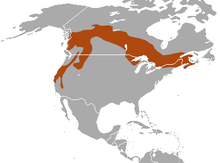Fisher marten
| Fisher | |
|---|---|
 |
|
| Scientific classification | |
| Kingdom: | Animalia |
| Phylum: | Chordata |
| Class: | Mammalia |
| Order: | Carnivora |
| Family: | Mustelidae |
| Genus: | Pekania |
| Species: | P. pennanti |
| Binomial name | |
|
Pekania pennanti (Erxleben, 1777) |
|
 |
|
| Fisher range | |
| Synonyms | |
|
List
|
|
The fisher (Pekania pennanti) is a small carnivorous mammal native to North America. It is a member of the mustelid family (commonly referred to as the weasel family) and is in the monospecific genus Pekania. The fisher is closely related to but larger than the American marten (Martes americana). The fisher is a forest-dwelling creature whose range covers much of the boreal forest in Canada to the northern United States. Names derived from aboriginal languages include pekan, pequam, wejack, and woolang. It is also called a fisher cat, although it is not a feline.
Males and females look similar. Adult males are 90 to 120 cm (35–47 in) long and weigh 3.5 to 6 kilograms (8–13 lb). Adult females are 75 to 95 cm (30–37 in) long and weigh 2 to 2.5 kg (4–6 lb). The fur of the fisher varies seasonally, being denser and glossier in the winter. During the summer, the color becomes more mottled, as the fur goes through a moulting cycle. The fisher prefers to hunt in full forest. Though an agile climber, it spends most of its time on the forest floor, where it prefers to forage around fallen trees. An omnivore, the fisher feeds on a wide variety of small animals and occasionally on fruits and mushrooms. It prefers the snowshoe hare and is one of the few animals able to prey successfully on porcupines. Despite its common name, the fisher rarely eats fish.
The reproductive cycle of the fisher lasts almost a year. Female fishers give birth to a litter of three or four kits in the spring. They nurse and care for their kits until late summer, when they are old enough to set out on their own. Females enter estrus shortly after giving birth and leave the den to find a mate. Implantation of the is delayed until the following spring, when they give birth and the cycle is renewed.
Fishers have few predators besides humans. They have been trapped since the 18th century for their fur. Their pelts were in such demand that they were extirpated from several parts of the United States in the early part of the 20th century. Conservation and protection measures have allowed the species to rebound, but their current range is still reduced from its historic limits. In the 1920s, when pelt prices were high, some fur farmers attempted to raise fishers. However, their unusual delayed reproduction made breeding difficult. When pelt prices fell in the late 1940s, most fisher farming ended. While fishers usually avoid human contact, encroachments into forest habitats have resulted in some conflicts.
...
Wikipedia

